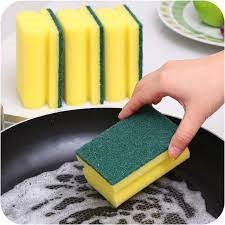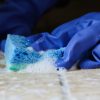- Empty cart.
- Continue Shopping
Keeping Your Dish Washing Sponge Hygiene and Clean

Keeping Your Dish Washing Sponge Hygiene and Clean
Bacteria accumulate and grow in a number of ways in the kitchen. Your sink and garbage disposal are one of these unclean places. As a result, doing your dishes by filling the sink with water and soap, then dipping and rinsing them is essentially a germ bath. They will pick up germs from those who washed before them, as well as bacteria that has accumulated in the sink.
Sponges are also good reproductive grounds for germs and become quickly infected following the first application. There can be up to 10 million bacteria. Therefore, if you wipe your sponge, you only disseminate all these microorganisms.
Whether you believe it or not, your moist sponge makes it easier for disease-causing germs to multiply, and it is also covered in food particles. In essence, you are providing the germs with everything they require to grow. That’s not a good thing, because you do not want to give your dinner guests cramps and cold sweats or rush your family to the toilet after a meal.
Consumers change their sponges most regularly, but sensory signals, such as looking filthy, smelly, slimy, can induce replacements for use in occurrences such as wiping meat juices. In addition to washing the dishes with dish cleaner, more than a quarter of consumers use it to clean the chopping board of chicken flesh juices and debris.
You are transmitting hazardous bacteria if you are not cleaning your kitchen sponge regularly. Target to cleanse the sponge once a week to keep a clean environment in the kitchen.
There are a few different ways to clean a sponge in the kitchen, including heat, natural ingredients, and more.
Clean the sponge in the microwave
A clean dish sponge reduces the chance that the kitchen contains bacteria. One of the best ways to clean sponges is by using a microwave. It is ideal for cleaning quickly and efficiently whenever you want to.
However, before putting the sponge in, rinse it and remove as many crumbs and other food waste as possible. Soak it in just enough water to make it soaked but not dripping, then zap it on high for a minute.
Before storing, rinse and dry.
You are very well aware of how food particles and moisture allow pathogens to proliferate. Take precautions to prevent their progress by cleaning the sponge or Scotch-Brite Microfiber Kitchen Cloth. After that, squeeze the sponge as much as possible to remove as much water as possible. Instead of storing the sponge at the bottom of the sink, place it in an area where it can thoroughly dry, such as a tiny sponge rack.
Use vinegar to clean the sponge.
A soak in full-strength vinegar also works if you prefer a more natural choice.
Before dumping the sponge into a container filled with enough vinegar to completely submerge it, remove any solid particles and give it a quick rinse and squeeze. You can also use an ideal dish cleaner to give a quick rinse.
Before rinsing and pressing, allow for a five-minute soak time. If you are doing this, use gloves since the extra acid in the vinegar-soaked sponge can injure your skin.
Use Bleach to Disinfect a Sponge
Another excellent choice for cleaning kitchen sponges is bleach. In addition to bacteria, it destroys viruses, mold, and mildew. To begin, combine 3/4 cup bleach with 1 gallon of water. Allow the kitchen sponge to soak for 5 minutes. Rinse well in warm water, and you are done.
Bleach and vinegar both have a strong odor. Always work in a well-ventilated space when cleaning with bleach.
Use Boil Water to Disinfect a Sponge
Microwaves are a popular alternative to cleaning kitchen sponges. But without the domestic appliance, it is just as easy to disinfect a sponge. Just clean the nasty sponge in the kitchen in a saucepan of boiling water. In a boiling kettle, bring 2 cups of water. In the boiling water, place the kitchen sponge and give it 5 minutes. Put the kitchen sponge on and ring off excess water. Cool completely in the water.
Disinfect a Sponge in the Dishwasher
The quickest option for all of them is to clean a kitchen sponge in a dishwasher. Put the sponge in the top rack and operate the sponge in the heat-dry cycle. But all heat-dry washing environments eliminate the bacteria in the kitchen sponge. The most effective cycle is the one that lasts the longest and heats the most.
Do’s and Don’ts with Kitchen Sponge
Keep the kitchen Sponge clean by following these do’s and don’ts.
Do’s
Sponges should be cleaned every day.
Wet sponges can be microwaved for one minute or placed in the dishwasher on the drying cycle. According to the UDSA, this destroys 99 percent of bacteria, yeasts, and molds.
Replace it Frequently
Your sponge can still teem with microorganisms after two or three uses, even if you are using a perfect dish cleaner to clean your dishes. Consider replacing it on a regular basis. If at some point, the sponge begins to smell, toss it aside immediately.
Maintain a Dry Environment
After each usage, wring out the sponge fully and wash away any loose food or dirt. Keep it in a dry place. Allowing the sponge to sit wet on a counter for an extended period of time causes it to take longer to dry and encourages bacteria to grow. Also, don’t put damp sponges in a closed container like a bucket or under the sink.
Don’t
Don’t be a Grinch
Mostly, sponges start to appear unclean or smell terrible. Some of us wait for sponges to collapse before they are thrown out. For weeks or months, a handful of us continue to use the same sponges.
A sponge that has been used and smells must be discarded. And don’t wait until they’re completely worn out to replace them.
Avoid Using Sponges to Wipe Up Meat Juices
Spills that are cleaned up with a sponge have a higher risk of transmitting hazardous foodborne germs. Instead, mop up the spillage from ground beef or poultry with a paper towel or disinfectant wipes.
Don’t Use Sponges on Countertops
Millions of microorganisms may be present in sponges. And only a few are enough to make you sick.
Cleaning surfaces with a paper towel or disinfectant wipe reduces the risk of transmitting germs.
How Often Do I Need to Replace My Sponges?
Depending on how much you use it, you should replace the sponge everywhere between once and once every 2 weeks. This means you can push off some more calendar days if your dinner plans normally consist of picking out a paper plate. You may protect your sponge from getting too sprouted so quickly by cleansing it daily.
Hygiene For All is a leading supplier in the cleaning chemical industry, with a national brand presence. We provide optimum quality cleaning chemicals & products such as dish cleaner, dish scrubber, Dish Washing Solution, Scotch-Brite Microfiber Kitchen Cloth as a reputable and well-known company in the market. We never cut corners when it comes to product quality, and we always meet deadlines.
The following are some of the key characteristics that make us the best choice:
- Products of the highest grade
- On-time shipping
- Options for the best packaging
- Simple Modes of payment
At Hygiene For All, a leading supplier of dish cleaner, we are capable of presenting a broad choice of biodegradable cleaning products with the assistance of skilled specialists. These are treated in accordance with industry guidelines and norms. In creating high-quality products, we acknowledge the necessity of high-quality raw materials. This means that we maintain a good relationship with respected suppliers of the market. Our company can easily complete wholesale consignments and deliver on time since our resource chain structure is properly managed.





